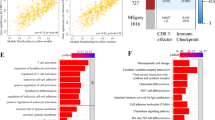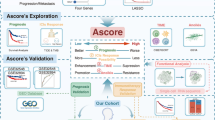Abstract
Background
Immune checkpoint blockade (ICB) therapy has become a first-line treatment option for metastatic urothelial carcinoma (mUC) patients who do not meet the criteria of cisplatin. Still, only a few people can benefit from it, so useful predictive markers are needed.
Methods
Download the ICB-based mUC and chemotherapy-based bladder cancer cohorts, and extract the expression data of pyroptosis-related genes (PRG). The LASSO algorithm was used to construct the PRG prognostic index (PRGPI) in the mUC cohort, and we verified the prognostic ability of PRGPI in two mUC and two bladder cancer cohorts.
Results
Most of the PRG in the mUC cohort were immune-activated genes, and a few were immunosuppressive genes. The PRGPI composed of GZMB, IRF1, and TP63 can stratify the risk of mUC. In IMvigor210 and GSE176307 cohorts, the P-values of Kaplan Meier analysis was < 0.01 and 0.002, respectively. PRGPI could also predict ICB response, and the chi-square test of the two cohorts had P-values of 0.002 and 0.046, respectively. In addition, PRGPI can also predict the prognosis of two bladder cancer cohorts without ICB therapy. The PRGPI and the expression of PDCD1/CD274 had a high degree of synergistic correlation. The Low PRGPI group showed prominent characteristics of immune infiltration and was enriched in the immune signal activation pathway.
Conclusion
The PRGPI we constructed can effectively predict the treatment response and overall survival rate of mUC patients treated with ICB. The PRGPI can help mUC patients achieve individualized and accurate treatment in the future.








Similar content being viewed by others
Data availability
There is no new data produced by this research.
References
Barbie DA, Tamayo P, Boehm JS, Kim SY, Moody SE, Dunn IF et al (2009) Systematic RNA interference reveals that oncogenic KRAS-driven cancers require TBK1. Nature 462(7269):108–112. https://doi.org/10.1038/nature08460. (PubMed PMID: 19847166)
Bellmunt J, De Wit R, Dj V, Fradet Y, Jl L, Fong L et al (2017) Pembrolizumab as second-line therapy for advanced urothelial carcinoma. N Engl J Med 376(11):1015–1026. https://doi.org/10.1056/NEJMoa1613683. (PubMed PMID: 28212060)
Callea M, Albiges L, Gupta M, Cheng Sc, Genega Em, Fay Ap et al (2015) Differential expression of PD-L1 between primary and metastatic sites in clear-cell renal cell carcinoma. Cancer Immunol Res 3(10):1158–1164. https://doi.org/10.1158/2326-6066.cir-15-0043. (PubMed PMID: 26014095)
Chen S, Zhang N, Wang T, Zhang E, Wang X, Zheng J (2020) Biomarkers of the response to immune checkpoint inhibitors in metastatic urothelial carcinoma. Front Immunol 11:1900. https://doi.org/10.3389/fimmu.2020.01900. (PubMed PMID: 32983112)
Chen X, Chen H, Yao H, Zhao K, Zhang Y, He D et al (2021) Turning up the heat on non-immunoreactive tumors: pyroptosis influences the tumor immune microenvironment in bladder cancer. Oncogene. https://doi.org/10.1038/s41388-021-02024-9. (PubMed PMID: 34588621)
Ei H, Je R (2021) The biology and rationale of targeting nectin-4 in urothelial carcinoma. Nat Rev Urol 18(2):93–103. https://doi.org/10.1038/s41585-020-00394-5. (PubMed PMID: 33239713)
Friedman J, Hastie T, Tibshirani R (2010) Regularization paths for generalized linear models via coordinate descent. J Stat Softw 33(1):1–22 (PubMed PMID: 20808728)
Fu J, Wang Y (2021) Identification of a novel pyroptosis-related gene signature for predicting prognosis in bladder cancer. Cancer Invest. https://doi.org/10.1080/07357907.2021.1991944. (PubMed PMID: 34644219)
Je R, Hoffman-Censits J, Powles T, Van Der Heijden Ms, Balar Av, Necchi A et al (2016) Atezolizumab in patients with locally advanced and metastatic urothelial carcinoma who have progressed following treatment with platinum-based chemotherapy: a single-arm, multicentre, phase 2 trial. Lancet (london, England) 387(10031):1909–1920. https://doi.org/10.1016/s0140-6736(16)00561-4. (PubMed PMID: 26952546)
Lin J, Ding M, Qin C, Song Y, Han H, Yang W, Du Y, Xu T (2022) Development and validation a pyroptosis related gene prognostic index for metastatic urothelial carcinoma based on immune checkpoint blockade therapy. PREPRINT (Version 1) available at Research Square. https://doi.org/10.21203/rs.3.rs-1625353/v1
Liu X, Xia S, Zhang Z, Wu H, Lieberman J (2021) Channelling inflammation: gasdermins in physiology and disease. Nat Rev Drug Discov 20(5):384–405. https://doi.org/10.1038/s41573-021-00154-z. (PubMed PMID: 33692549)
Loveless R, Bloomquist R, Teng Y (2021) Pyroptosis at the forefront of anticancer immunity. J Exp Clin Cancer Res 40(1):264. https://doi.org/10.1186/s13046-021-02065-8. (PubMed PMID: 34429144)
Mariathasan S, Sj T, Nickles D, Castiglioni A, Yuen K, Wang Y et al (2018) TGFβ attenuates tumour response to PD-L1 blockade by contributing to exclusion of T cells. Nature 554(7693):544–548. https://doi.org/10.1038/nature25501. (PubMed PMID: 29443960)
Mclaughlin J, Han G, Ka S, Carvajal-Hausdorf D, Pelekanou V, Rehman J et al (2016) Quantitative assessment of the heterogeneity of pd-l1 expression in non-small-cell lung cancer. JAMA Oncol 2(1):46–54. https://doi.org/10.1001/jamaoncol.2015.3638. (PubMed PMID: 26562159)
Mootha Vk, Lindgren Cm, Eriksson Kf, Subramanian A, Sihag S, Lehar J et al (2003) PGC-1alpha-responsive genes involved in oxidative phosphorylation are coordinately downregulated in human diabetes. Nat Genet 34(3):267–273. https://doi.org/10.1038/ng1180. (PubMed PMID: 12808457)
Riester M, Werner L, Bellmunt J, Selvarajah S, Guancial Ea, Weir Ba et al (2014) Integrative analysis of 1q23.3 copy-number gain in metastatic urothelial carcinoma. Clin Cancer Res 20(7):1873–1883. https://doi.org/10.1158/1078-0432.ccr-13-0759. (PubMed PMID: 24486590)
Robertson Ag, Kim J, Al-Ahmadie H, Bellmunt J, Guo G, Cherniack Ad et al (2017) Comprehensive molecular characterization of muscle-invasive bladder cancer. Cell 171(3):540–56.e25. https://doi.org/10.1016/j.cell.2017.09.007. (PubMed PMID: 28988769)
Rose TL, Weir Wh, Mayhew Gm, Shibata Y, Eulitt P, Uronis Jm et al (2021) Fibroblast growth factor receptor 3 alterations and response to immune checkpoint inhibition in metastatic urothelial cancer: a real world experience. Br J Cancer. https://doi.org/10.1038/s41416-021-01488-6. (PubMed PMID: 34294892)
Siefker-Radtke A, Curti B (2018) Immunotherapy in metastatic urothelial carcinoma: focus on immune checkpoint inhibition. Nat Rev Urol 15(2):112–124. https://doi.org/10.1038/nrurol.2017.190. (PubMed PMID: 29205200)
Sjödahl G, Lauss M, Lövgren K, Chebil G, Gudjonsson S, Veerla S et al (2012) A molecular taxonomy for urothelial carcinoma. Clin Cancer Res 18(12):3377–3386. https://doi.org/10.1158/1078-0432.ccr-12-0077-t. (PubMed PMID: 22553347)
Sun D, Wang J, Han Y, Dong X, Ge J, Zheng R et al (2021) TISCH: a comprehensive web resource enabling interactive single-cell transcriptome visualization of tumor microenvironment. Nucleic Acids Res 49:D1420–D1430. https://doi.org/10.1093/nar/gkaa1020. (PubMed PMID: 33179754)
Wang Q, Wang Y, Ding J, Wang C, Zhou X, Gao W et al (2020) A bioorthogonal system reveals antitumour immune function of pyroptosis. Nature 579(7799):421–426. https://doi.org/10.1038/s41586-020-2079-1. (PubMed PMID: 32188939)
Xi G, Gao J, Wan B, Zhan P, Xu W, Lv T et al (2019) GSDMD is required for effector CD8 T cell responses to lung cancer cells. Int Immunopharmacol 74:105713. https://doi.org/10.1016/j.intimp.2019.105713. (PubMed PMID: 31276977)
Zhang Z, Zhang Y, Xia S, Kong Q, Li S, Liu X et al (2020) Gasdermin E suppresses tumour growth by activating anti-tumour immunity. Nature 579(7799):415–420. https://doi.org/10.1038/s41586-020-2071-9. (PubMed PMID: 32188940)
Zhou Z, He H, Wang K, Shi X, Wang Y, Su Y et al (2020) Granzyme A from cytotoxic lymphocytes cleaves GSDMB to trigger pyroptosis in target cells. Science. https://doi.org/10.1126/science.aaz7548. (PubMed PMID: 32299851)
Acknowledgements
This article has been presented as a preprint in the researchsquare (Lin et al. 2022) (https://www.researchsquare.com/article/rs-1625353/v1)
Funding
This work was supported by National Key Research and Development Program of China (no. 2018YFA0902802), Natural science foundation of Beijing, China (no. 7202219), National natural science foundation of China (no. 81802533), Beijing Municipal Science & Technology Commission (no. Z191100006619010).
Author information
Authors and Affiliations
Contributions
JL, MD, and CQ conducted data analysis and written manuscripts; YS, JH, and WY assisted in drawing pictures and collecting data; YD and TX provided ideas and designed experiments.
Corresponding authors
Ethics declarations
Conflict of interest
The authors have no relevant financial or non-financial interests to disclose.
Ethical approval
Not applicable.
Consent to publish
Not applicable.
Additional information
Publisher's Note
Springer Nature remains neutral with regard to jurisdictional claims in published maps and institutional affiliations.
Supplementary Information
Below is the link to the electronic supplementary material.
Rights and permissions
Springer Nature or its licensor (e.g. a society or other partner) holds exclusive rights to this article under a publishing agreement with the author(s) or other rightsholder(s); author self-archiving of the accepted manuscript version of this article is solely governed by the terms of such publishing agreement and applicable law.
About this article
Cite this article
Lin, J., Ding, M., Qin, C. et al. A robust gene prognostic index composed of GZMB, IRF1, and TP63 can stratify the risk of two metastatic urothelial carcinoma cohorts based on immune checkpoint blockade therapy. J Cancer Res Clin Oncol 149, 9877–9890 (2023). https://doi.org/10.1007/s00432-023-04902-z
Received:
Accepted:
Published:
Issue Date:
DOI: https://doi.org/10.1007/s00432-023-04902-z




